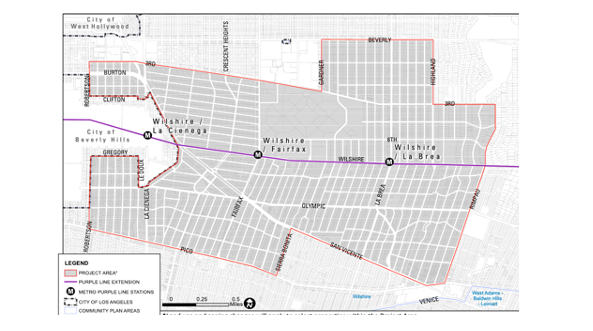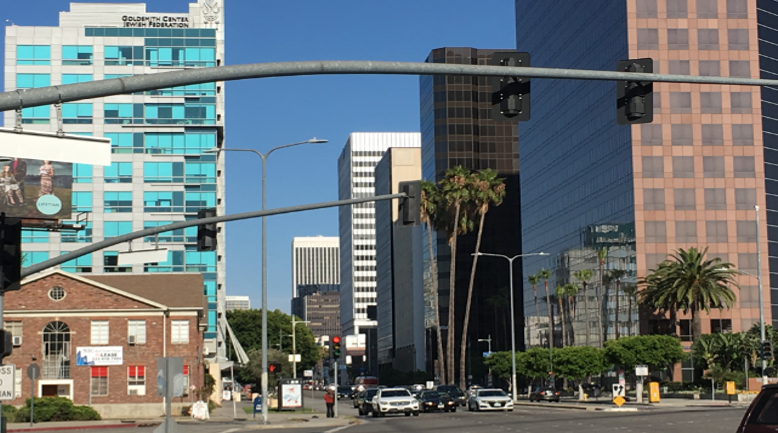CommentsPLANNING WATCH-The Los Angeles City Planning Department recently announced that it is terminating work on its long-stalled Purple Line Extension "Transit Neighborhood Plan" (TNP).
Instead, it will fold this controversial developer give-away scheme into the forthcoming Update of the Wilshire Community Plan. That Update is scheduled to begin in 2022, which marks 20 years since the Wilshire Plan’s previous update and nine years since METRO first paid Los Angeles $4,480,000 to prepare the Purple Line and several other Transit Neighborhood Plans.
This is exactly what community representatives repeatedly requested from the two Council Offices representing the Miracle Mile area. In these meetings, plus on the pages of CityWatch, local residents raised serious objections to the Purple Line Transit Neighborhood Plan. In part they pointed out that:
- The Transit Neighborhood Plan had nothing to do with transit. It would not reduce or eliminate fares or make it easier for nearby residents to use the future subway. It left sidewalks in their same deplorable state. It did not upgrade street lighting, plant street trees, or install bicycle/scooter lanes and parking areas. It did not incorporate car, pedestrian, scooter, bicycle, and bus interfaces at stations. It did not provide covered shelters for bus stops. It did not install METRO Bike Share facilities at subway stations.
Why? Because the TNP’s unstated purpose was to make it easier for real estate investors to flip their properties or build expensive, car-oriented apartments near new subway stations and on LaBrea Avenue, Fairfax Avenue, and San Vicente Boulevard. Even though local transportation upgrades were clearly part of the original 2013 METRO grant, streetscape, pedestrian improvements, and bicycle infrastructure were never included in City Planning’s TNP proposal or in METRO’s $3 billion (and still growing) budget for this section of the Purple Line subway extension.
- The Transit Neighborhood Plan was totally detached from nearby neighborhoods. Local neighborhood groups have been totally opposed to this project, especially the Greater Wilshire and PICO Neighborhood Councils. They were adamant that all planning for this area must be part of the long-delayed Wilshire Community Plan Update, not separated into a parallel planning process to benefit commercial property owners. They also pointed out that treating the Purple Line Extension area separate from the Wilshire Community Plan would result in a lawsuit similar to the Fix-the-City suit challenging the Expo Transit Neighborhood Plan. That suit maintains that the General Plan Framework’s policies 3.3.1 and 3.3.2 require growth-inducing up-zoning ordinances, like the TNP, to document sufficient supporting infrastructure and public services.
- The Neighborhood Plan was not a real plan. Despite its impressive name, the TNP is nothing more than a zoning concept that could eventually become a Council-adopted zoning ordinance. It would then grant extra height, size, and density to real estate projects within a half-mile from the Purple Line subway, as shown in the study area map
 Map of Purple Line Extension Transit Neighborhood Plan study area.
Map of Purple Line Extension Transit Neighborhood Plan study area.
As enthusiastic as local residents are that City Hall finally abandoned a detested zoning proposal, they need to remember that no victories are permanent. Furthermore, they don’t yet know why City Planning threw in the towel on the Purple Line TNP. Was it a fear of lawsuits? Council offices trying to placate angry constituents? Competing projects? So far, City Hall’s about face remains a mystery.
Nevertheless, one thing is certain. If City Planning actually starts the Wilshire Community Plan Update in 2022, they will be three years behind schedule. The public should, therefore, expect the same rushed approach that Planning has rolled out for ongoing Community Plan updates in the Southwest Valley, Southeast Valley, and West LA.
Assembling basic information is necessary for a valid Community Plan Update. To be sure that the jettisoned TNP does not reappear with a new name, local Wilshire area communities must carefully birddog the forthcoming Update process. To protect their communities, they must insist that the following data guide the Update’s goals, policies, and implementation and monitoring programs.
- The amount of additional housing that can be added to the Wilshire Community Plan untapped zoning capacity through ministerial (administrative) approvals, including Density Bonuses, Accessory Dwelling Units (ADUs), Junior Accessory Dwelling Units (JADUs), and small mobile houses.
- The amount of housing forecast in the Wilshire Community Plan area through routine discretionary approvals, including TOC Guidelines, Senate Bill 1818, Community Plan Implementation Ordinances, and/or Community Benefit Agreements.
- The capacity of local infrastructure and public services to support additional people and residences in the Wilshire Community Plan’s many neighborhoods.
- Current vacancy rates for middle income and luxury apartments in the Wilshire Community Plan area, including neighborhoods with close access to METRO Rapid buses and the Red and Purple subway lines?
- Anticipated population growth and housing construction in the Wilshire Community Plan’s different neighborhoods.
Without these precautions, the Update could become an unplanned mess of new, expensive apartments that make the transit and housing crises worse.
(Dick Platkin is a former Los Angeles city planner who reports on local planning issues for CityWatch. He serves on the board of United Neighborhoods for Los Angeles (UN4LA) and co-chairs the new Greater Fairfax Residents Association. Previous Planning Watch columns are available at the CityWatchLA archives. Please send comments and corrections to [email protected].) Prepped for CityWatch by Linda Abrams.
















